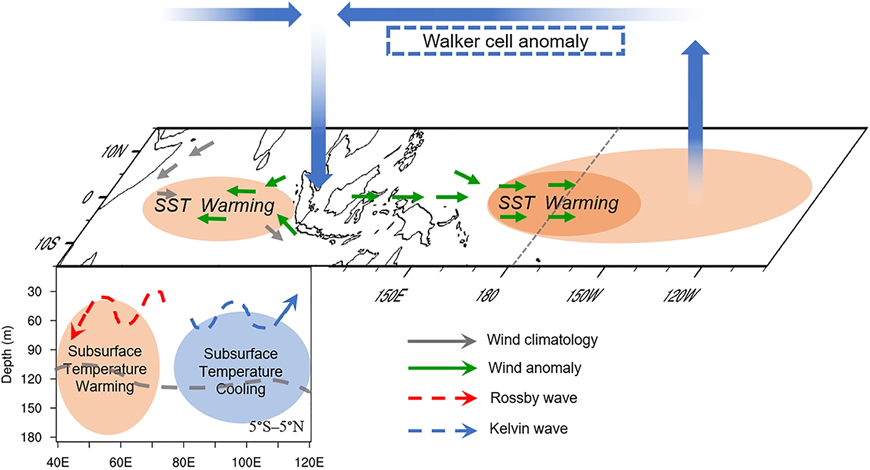中国科学院大气物理研究所大气科学和地球流体力学数值模拟国家重点实验室
State Key Laboratory of Numerical Modeling for Atmospheric Sciences and
Geophysical Fluid Dynamics (LASG)
Institute of Atmospheric Physics, Chinese Academy of Sciences
State Key Laboratory of Numerical Modeling for Atmospheric Sciences and
Geophysical Fluid Dynamics (LASG)
Institute of Atmospheric Physics, Chinese Academy of Sciences

Vol.17/No.17 April 2022
Study Discloses an Intrinsic Upper-Ocean Temperature Variability in the Tropical Indian Ocean
Recently, researchers from China and U.S.A. did a series of studies concerning the subsurface variability and further identified an inherent oscillation with a quasi-regular period around 15 months in the TIO subsurface temperature, which forms the baseline of the IOD variability.
The researchers provided a deep analysis of the peak phases in this equatorial oscillation that is characterized by a subsurface east-west dipole pattern called subsurface Indian Ocean dipole (Sub-IOD). Most Sub-IOD events co-occur with a surface IOD in autumn. However, some Sub-IOD events still can develop in winter-to-spring independent of the surface IOD. These Sub-IOD events are closely connected to the western-type Central Pacific El Nino–Southern Oscillation (ENSO).
"Our results may advance our understanding of the interactions between the surface and subsurface, as well as the remote influences from different ENSO events on their occurrence, and improve future projections of the IOD and its effects on the Earth's climate." said SONG Ge, the lead author with the Institute of Atmospheric Physics at the Chinese Academy of Sciences.

Schematic diagram of the linkage between a positive Sub-IOD and a western-type CP El Nino in the boreal winter-to-spring. (Image by SONG Ge)
These studies have been published in Journal of Climate and Geophysical Research Letters.
Citation:
Song, Ge*, Bohua Huang, Rongcai Ren*, and Zeng-Zhen Hu., 2021: Basin-wide connections of upper-ocean temperature variability in the equatorial Indian Ocean. J. Climate, 1-50. https://doi.org/10.1175/JCLI-D-20-0419.1
Link: https://doi.org/10.1175/JCLI-D-20-0419.1
Song, Ge., & Rongcai Ren*, 2022: Linking the subsurface Indian Ocean dipole to Central Pacific ENSO. Geophysical Research Letters, 49, e2021GL096263. https://doi.org/10.1029/2021GL096263
Link: https://doi.org/10.1029/2021GL096263
Contact: REN Rongcai, rrc@lasg.iap.ac.cn; SONG Ge, songge@mail.iap.ac.cn
Add: No.40, Huayanli, Beichen West Road, Chaoyang District, Beijing P.O. Box 9804, 100029, China
E-mail: lasg_newsletter@lasg.iap.ac.cn
Editors: Chuanyi Wang (wangcy@lasg.iap.ac.cn), Kangjun Chen(ckj@lasg.iap.ac.cn)
E-mail: lasg_newsletter@lasg.iap.ac.cn
Editors: Chuanyi Wang (wangcy@lasg.iap.ac.cn), Kangjun Chen(ckj@lasg.iap.ac.cn)